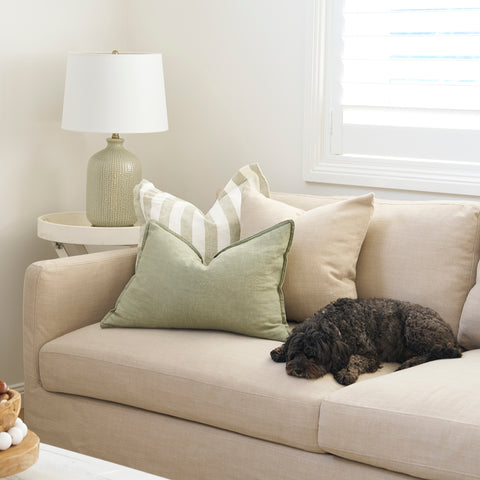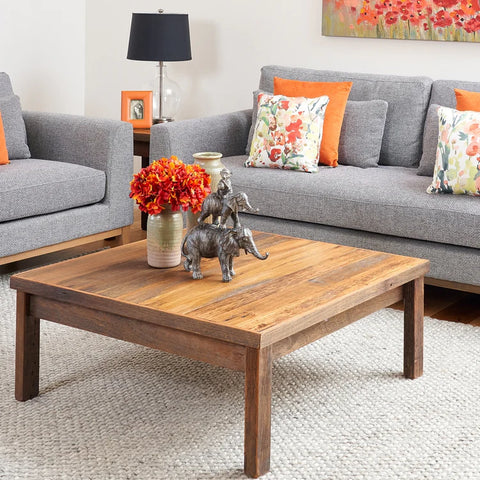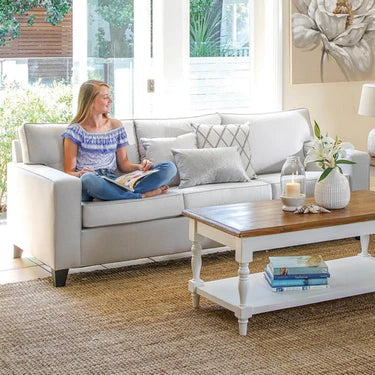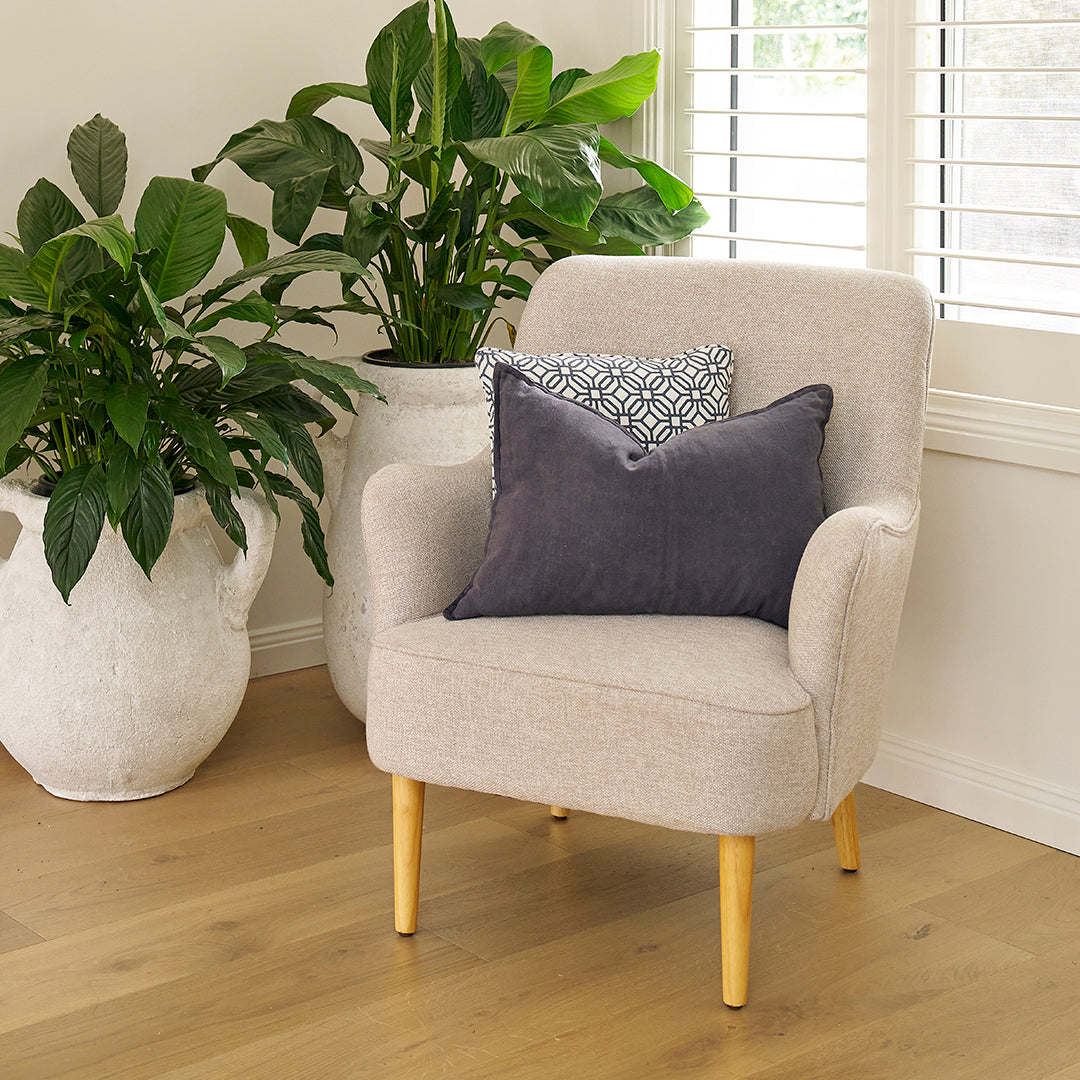Who doesn’t love collapsing into a pillowy pile of colourful cushions? Whether you’re seeking secondary support on the couch or something snuggly for the bedroom, cushions are the easiest and most stylish home decor solutions. Whilst it’s one thing to throw your throw cushions onto the couch or bed in any chaotic combination, it’s quite another to arrange them in a colourful bouquet fit for Instagram. Want to know how to style cushions like a pro? In that case, heed our tips below!

Image: 1825 Interiors
Tip #1: Layer with different pillow sizes
Cushions come in different shapes and sizes, and layering is a great way to showcase the varying sizes of your collection. For an optimal arrangement, assemble your cushions as people would pose for a group photo: largest or tallest at the back with smaller or shorter types towards the front. By arranging cushions from largest to smallest in such a way, you’re not only giving each a chance to shine but also building a foundation for the smaller cushions. It’s only logical that smaller cushions would embroider their larger counterparts rather than hide behind them.
When layering cushions, never use fewer than three or more than six cushions—unless you’re decorating a king-sized bed or the corner of a larger couch, in which case you can exceed six. When decorating standard-sized couches or queen-sized beds, using three to six cushions is the perfect way to stay comfortable without crowding out the space. Here is a great example of layering with different sizes:

Image: 1825 Interiors
Cast your eyes to the couch’s middle corner: there lie four cushions, the forwardmost three of which seemingly cascade from their larger base cushion. See how the tallest takes the back whilst the middle two stylishly spring forth from this base? The front cushion is by far the smallest, and its rectangular (as opposed to square) shape closes off the arrangement. We could also discuss how these cushions complement and offset one another with their same-same-but-different colours and patterns, but that’s our next point.
Tip #2: Mix and match colours and patterns
This is a tip to tickle the fancy of all arty types out there. Mixing and matching colours and patterns is a surefire way to add visual variety and texture to any living room. Although we mentioned this earlier, it bears repeating that throwing any old throw cushions together is not the same thing as careful curation. Sure, it’s fun to play around with different combinations, but there certainly is an art to it.

Image: 1825 Interiors
The above example features colour and pattern combinations that meld together seamlessly. Whilst the backmost cushions add an extra layer to the grey couch, the orange and floral additions take cues from the photo frame, flowers, and the poppy painting on the wall. Much like the vibrant, autumnal flowers themselves, these crisp-hued cushions add a dash of colour to an otherwise cloudy display. Introducing a second colour to a fairly monotonal arrangement is a great way to create simple yet effective colour theming. In this case, we’ve chosen orange as our accent colour—aka the colour that makes the room pop!

Image: 1825 Interiors
Above is a more subtle example of mixing and matching. If you look closely enough, you’ll notice the front cushion is a shimmery silver that sneaks in a blink-and-you’ll-miss-it colour contrast. The accent cushion, though, stands out not due to its hue but because of its simple criss-cross pattern. So, if you’re a fan of a more neutral living room aesthetic, you may wish to mix and match more muted tones and understated patterns. You don’t necessarily need bold colours to create movement and visual interest.
Tip #3: Choose the right materials
Choosing the right materials isn’t as straight-laced a process as keeping a colour theme. This is your time to run a little wild with your selections and embrace that fuzz and tassel-edged detailing! When choosing your cushions, you can create visual interest in one of two ways:
- By leveraging the prints and colours (which we have already covered) or
- By playing around with texture and tactile features.
Although the two approaches are, by no means, mutually exclusive, we’re going to focus on how you can use different materials to literally add an extra dimension to your pillow arrangement. You can take a rather liberal approach to it, too!

1825 Interiors’ Anisah Cotton Cushion and Zohra Cotton Cushion bringing out the best in each other.
In the above example, our Anisah and Zohra cushions bring out the best in each other. Linked by a pale blue hue, these two introduce a tactile quality to this living room layout. See how they speak with a respective snuggly surface and tactile tapestry texture, almost inviting you to take a seat? Their contrast against the rustic yet somewhat barren floorboards feels particularly welcoming in lieu of a carpet.

1825 Interiors’ Jacquard Stripe Cushion and Skye Blue Jacquard Tile Cushion bringing the contrast and tassels.
We could speak of our Jacquard cushions’ crocheted textures above, but we’ll instead focus on the edge embellishments. Tassels can be a terrific way to add whimsy or extra detailing to an already-cosy cushion. See how they trickle down the side and almost literally take the edge off? They work well in this example because they introduce a free-flowing feeling to a room with a relatively ‘short-haired’ carpet.
When leading with materials and textures, you should always take cues from your environment—just as you would with any other interior design choice. Whilst colour- and pattern-based choices should tie in and meld with the room around them, materials and textures often offset their surroundings. This is no fixed rule, of course, but it’s also the best way to have your hardwood flooring and sneak in your snuggly vibes, too.
Cushioning the blow
Arguably the most impractical home decor items on the market, cushions hold a soft spot in our hearts. They can be a chaotically comfortable collection of colours, patterns, and textures, but finding a way to work these features is the key to how to style cushions like a pro. Now you know how cushions can work together—by size, quantity, and aesthetics—you’re well on your way to creating a beautiful bedroom or living space. Why not get started right now?

